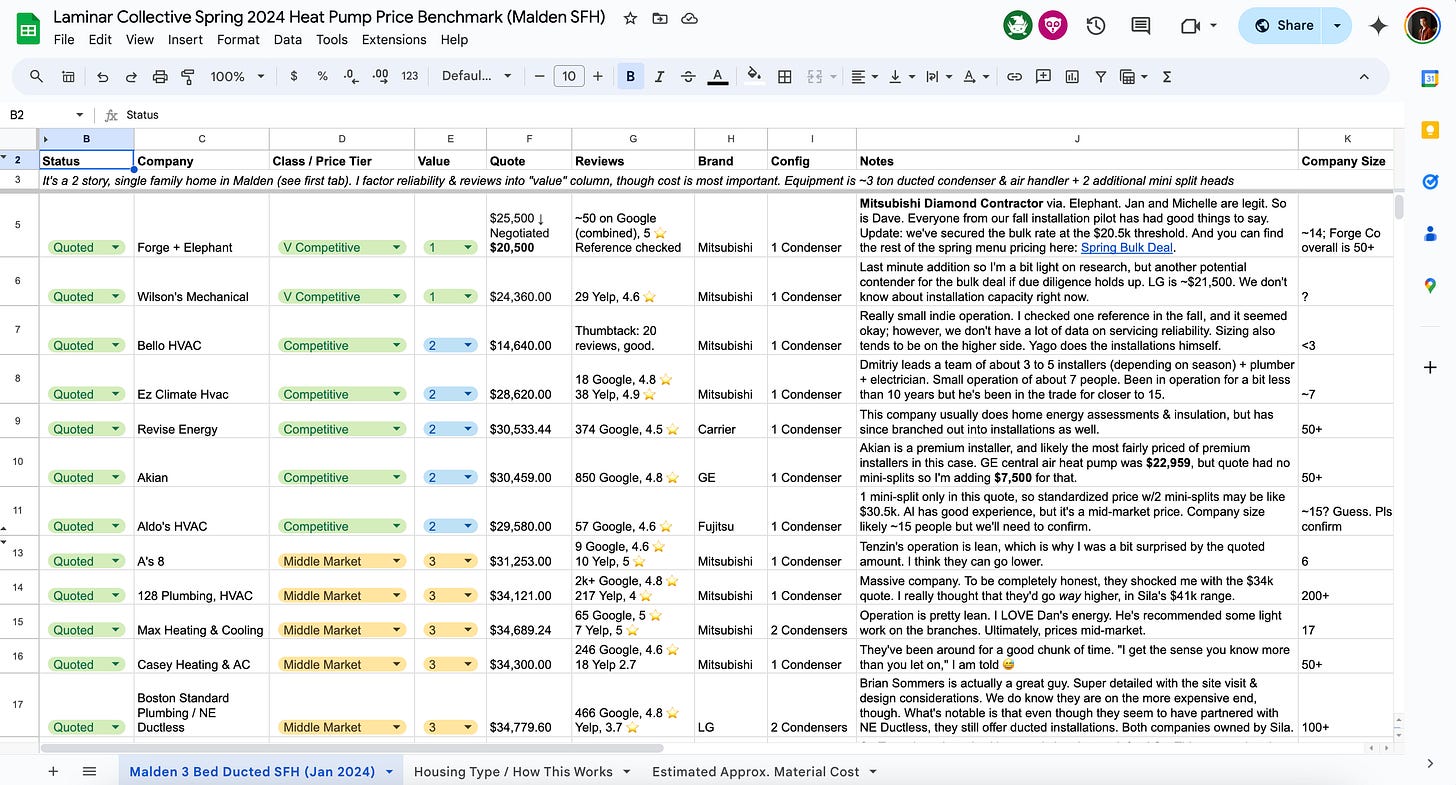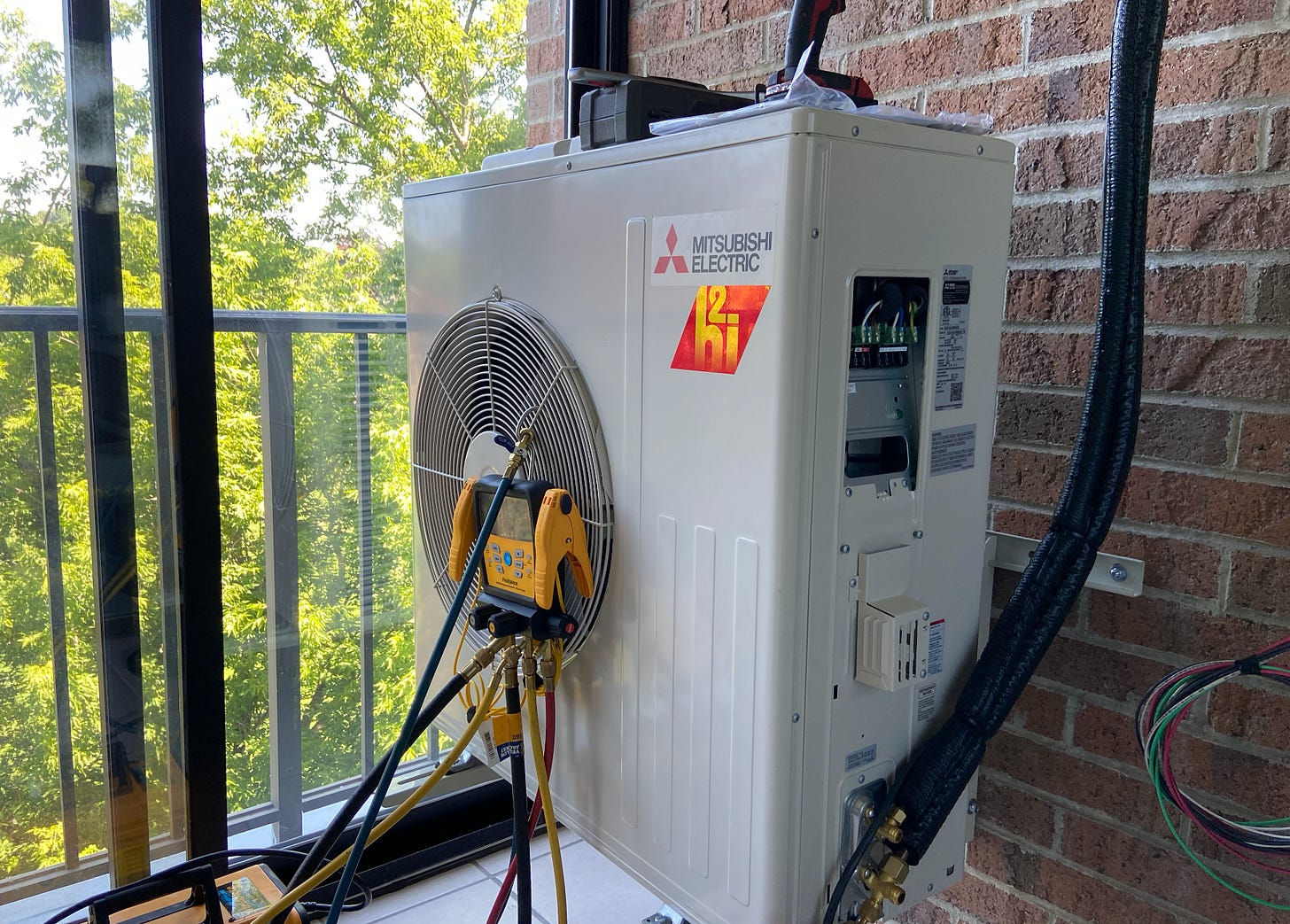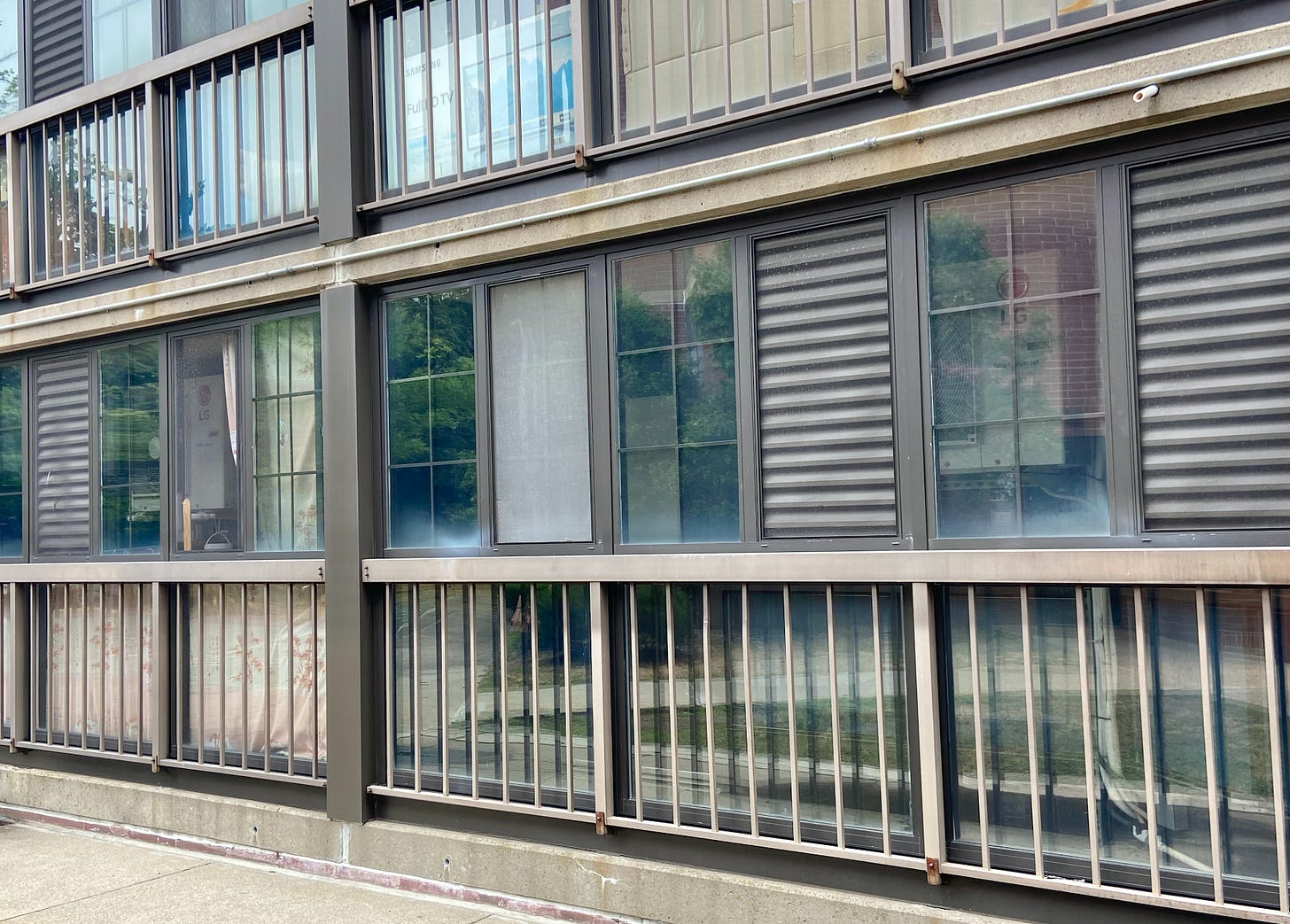Laminar Collective's Public Comment on Mass Save's 2025-2027 Draft Plan
Annotated, with Photos
August 15, 2024
Members of the Massachusetts Energy Efficiency Advisory Council
Re: Comments on the Draft Plan for Mass Save, 2025-2027
Thank you for the chance to provide feedback on the Draft Mass Save 2025-2027 Three-Year Plan (“draft plan”). Mass Save runs one of the most robust clean energy incentive programs in the nation, and I’m encouraged by the continued commitment from the state & public to improve it.
My name is Kit Wu and I run a research & organizing group called Laminar Collective. We are a Mass Save Community Education Grant recipient, and for the past year, we have been focused on making heat pumps more accessible to the mass market by lowering prices on high-quality installations. To that end, we have been tracking price trends in the heat pump installation market and facilitating bulk deals. Based on what we have observed in the field, we believe that the next 3-year plan must keep installation cost & quality in focus.
This letter addresses 4 points along those lines: price transparency, quality standards, multifamily incentives & renters, and electricity prices.
Price Transparency
How much does a heat pump installation cost today? Well, for a single family Colonial-styled home in Malden looking for a central AC replacement & 2 mini-splits, it’s anywhere from $23,000 to $50,000 (pre-rebate) in the off-season. If it’s a heat wave during the summer, you’d pay closer to the upper range; anytime between January and the end of tax filing season, you’d pay closer to the lower.
We know this because we conduct research studies on a seasonal basis. Unfortunately, a lot of homeowners don’t. They end up calling the HVAC contractors that bought up a billboard on I-93, and end up wondering if $50,000 is a reasonable price – because if that’s what it costs, it’s out of their budget and they’re not going to get a heat pump.
We operate in a minimally transparent market. It’s hard to know what a fair price is. It’s hard to know which contractors offer a high-quality installation at that fair price. We find it slightly concerning that the draft plan does not address the perpetually rising costs of an inefficient contractor market, which, along with high electricity costs, threatens to curb adoption for all households, and LMI households[1] in particular.
Mass Save does not have control over many market factors, such as rising equipment prices, and we know that. However, Mass Save is uniquely in the position of having pricing data from tens of thousands of quotes, submitted via. HEAT Loan applications & rebates, tied to contractor & installation details. We believe that publishing an anonymized database of these quotes on an annual or quarterly basis would be a huge benefit to market transparency, and would allow researchers & consumers to more easily identify the contractors who are quoting fair prices in this market.
Quality Standards
We care a lot about cost & affordability at Laminar Collective, and in a market where quality is easy to assess for consumers, we would spend most of our time focusing on price. But the fact that heat pump installations tend to be one-time custom services means that it’s uniquely hard for consumers to assess quality, particularly with information asymmetry between homeowners & contractors.
This is why we believe Mass Save must be rigorous with quality standards, and openly publish its vetting criteria for contractors doing income-eligible or turnkey installations.
One great place to start is with permits & inspections. At a minimum, installations under those categories should have all proper permits pulled, and inspections passed. No permit, no payment.
This is an area where cities & towns are uniquely positioned to help: currently, it is difficult for homeowners to figure out what permits are even required for a particular installation, whether that be sheet metal, mechanical, or electrical. Municipal websites are oftentimes designed for contractors, not homeowners. Cities can improve upon this by adding a simple, 3-sentence guide to permits required for ductless, ducted furnace swap, and mixed equipment installations. They can take it a step further by standardizing permitting requirements by region.
They can also streamline the actual inspections process. We have also encountered, during one of our 75+ installations this year, some inspections departments that don’t even offer the ability for contractors to schedule inspections ahead of time. You’d have to call every morning to see if the inspector is available on that day or particular week.
This is time-consuming for contractors, and a major potential obstacle for medium-income rental installations, because the contractor would have to call the owner, who would have to contact the renter to see if they are available on short notice. Solving the scheduling problem would make it easier to facilitate installations for renters while enforcing a quality baseline.
Another area to focus on is the response time, design, and project management for consumers. We agree with several of the other public comment letters from towns, and in particular Arlington, that CAP agency communication & response times have been hit or miss. We have also seen installations in certain public housing complexes north of Boston in which the condensers are located inside a mostly-enclosed balcony with minimal exterior airflow, which adversely impacts performance & longevity. This should not have happened.
We heavily encourage more consideration on quality control in future income-eligible & turnkey programs. If a contractor consistently underperforms on quality standards, they should not be eligible for those programs.
Multifamily Incentives, Renters, & Electricity Prices
Multifamily – as in 5+ unit buildings – is hard. Especially when you get to the 10+ unit scale. Standard considerations of condenser placement & line set runs get tossed out the window, as there are no unfinished attics or basements to hide refrigerant lines. Older buildings may not even have floor plans, and the condensate drains locations are unknown. Draining off the balcony? I don’t know about that; some building managers allow it, but others do not. Wait, does this building need lead remediation?
Installing heat pumps in a multifamily building is significantly more difficult than, say, a single family home in MetroWest. It requires more planning. And it requires a greater degree of general contracting work, particularly if it involves taking down walls & putting them back up again. As it happens, there are way more renters in multifamily housing than in single family housing.
If Mass Save wants to make inroads on multifamily rental housing, we’re going to need more than the existing $1,250 per ton incentive. But beyond funding, I also think 2 other things need to be improved:
1. The HEAT Loan application process.
2. Electricity prices.
HEAT Loans. We ran into this problem as we were facilitating a 10-unit bulk deal for a condo. To obtain a HEAT Loan, an applicant needs to provide a HEAT Loan intake form, which typically is handed out after a Home Energy Assessment. While this makes sense for buildings with 5 units or less, it doesn’t make sense for a ~50 unit condo tower; are you going to do a Home Energy Assessment for all 50 units, when most of them have the exact same insulation?
In some cases, it’s entities such as RISE Engineering that are responsible for the equivalent of the Home Energy Assessment. Unfortunately, when individual residents reach out to Mass Save’s phone number, they never actually end up talking to RISE. The operator who picks up (they’re great people, by the way) typically doesn’t know how to handle multifamily/condo cases. It took us a total of 7 phone calls to actually find out who to email to obtain a HEAT Loan intake form during our bulk deal, and then from there we needed to forward a completed HEAT Loan intake form to someone who hands it over to CLEAResult.
We were willing to do this because we are community organizers and a research organization that wanted to very specifically find out what the friction points of this process were. If we’re talking about a building owner or apartment resident, they aren’t going to go through with this process. They’re just going to not get heat pumps.
We recommend that Mass Save takes these unique design considerations into account for any process upgrades in the future, particularly as they “focus on decarbonizing renter-occupied, multifamily buildings without increasing tenant energy burdens” (as mentioned on Page 79).
Electricity Prices. We have, in the past, fairly vocally (via. letter to DPU) raised high electricity prices as a major risk to mass electrification in the medium-run. We continue to raise this as a concern, particularly for larger multifamily buildings & condos. Many of the multifamily properties we’ve seen run on gas, and that almost immediately eliminates the possibility of electrifying the building based on impact to heating bills.
Community choice aggregations help. In many communities, a 20% decrease in the most affordable rate makes a big difference for households that do switch from natural gas to heat pumps. But a 20% discount masks a dilemma for Mass Save and utilities: ultimately, we are going to need to figure out how to lower the cost of electricity across the board for ratepayers. This is especially critical if Mass Save does, in fact, start to decrease whole-home heat pump incentives starting in 2026, as the draft plan indicates on Page 113.
One More Thing
One of the most common situations that derails a heat pump installation is a household finding out that they need a service upgrade, and that it’s going to be an extra $5,000 or $6,000 added to the installation. At that point, the contractor has already come out, potentially done some design work, and energy coaches may already have spent time helping this household out.
There’s a unique opportunity for Mass Save utilities to provide cities and towns with access to service data for LMI households (and ideally, for everybody) so we can more proactively inform consumers if they may need to upgrade their electrical service & panel. This would help sustainability managers, energy coaches, and contractors alike.
Conclusion
We believe that mass market adoption only happens when installation prices are affordable, and high-quality. Making it easy to identify contractors who are in that sweet spot, and helping them grow their businesses by directing market demand to them, is critical to the long-term policy goals of Massachusetts. We hope that Mass Save will consider taking steps in this direction in the next 3 years.
Sincerely,
Kit Wu
Founder, Laminar Collective
[1] One only needs to look at National Grid running out of funding for the income-eligible rebates in July 2024 to feel the real-world impact of persistent cost inflation.









A race to the bottom. Complete garbage. Let the free market work as its intended. Rather than focusing on the lowest price possible, which forces all companies to make cuts that ultimately effects the quality they bring to the table, why not hyper focus on establishing a standard for quality?